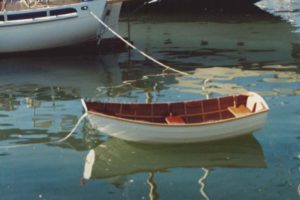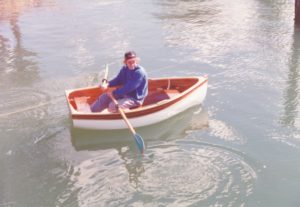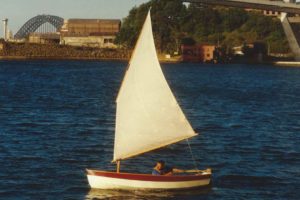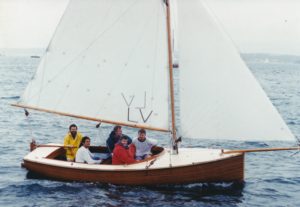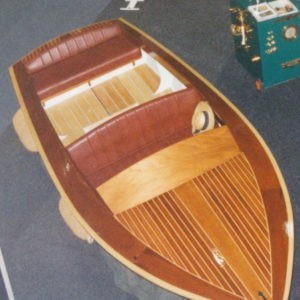We have gathered together a small group of wooden boat plans from several different designers, including dinghies, sailing vessels and power boats. All have been built through the School, some of them multiple times. Many of them can be built with a choice of methods, from fully traditional to modern laminated methods. Some appear below, and we will continuously add to the list. How to build them was written up in the Sydney Wooden Boat School Manuals which evolved from the classes at the School in the 1990’s, and they have been updated and combined into a single book which comprises the original manuals “Building a Traditional Clinker Dinghy”, “Epoxy Strip Planking”, “Plywood Clinker Construction” and “Building the Whiting Skiff” as well as a new section on “Carvel Planking”. It is available from our Shop Page now.
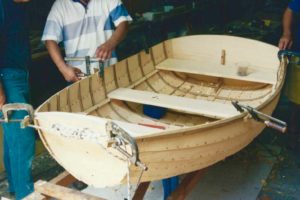 Pee Wee is an ideal yacht tender at 2.1m (6’8″)and can be built with traditional clinker planking, plywood clinker planking or strip planking. The original Pee Wee was designed by Ian Smith to be the tender to his canoe yawl Tirrick in the 1980’s and was strip-planked and sheathed with glass cloth set in WEST System Epoxy resin. It was such a stable little dinghy that Ian drew up a traditional clinker construction plan and it became the subject of the majority of the Sydney Wooden Boat School’s Traditional Clinker classes in the 1990’s, some planked in Huon Pine and some in Australian Red Cedar, and one in White Beech. The Traditional Clinker manual, also available, focuses on the building of her bigger sister Petrel, a very similar boat.
Pee Wee is an ideal yacht tender at 2.1m (6’8″)and can be built with traditional clinker planking, plywood clinker planking or strip planking. The original Pee Wee was designed by Ian Smith to be the tender to his canoe yawl Tirrick in the 1980’s and was strip-planked and sheathed with glass cloth set in WEST System Epoxy resin. It was such a stable little dinghy that Ian drew up a traditional clinker construction plan and it became the subject of the majority of the Sydney Wooden Boat School’s Traditional Clinker classes in the 1990’s, some planked in Huon Pine and some in Australian Red Cedar, and one in White Beech. The Traditional Clinker manual, also available, focuses on the building of her bigger sister Petrel, a very similar boat.
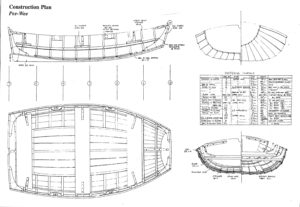 The Traditional Clinker construction plan contains the fastening list as well. The plans contain full size patterns for the moulds and for the bow and stern transoms, so no lofting is necessary. Details for ply clinker and strip-planked construction are also included.
The Traditional Clinker construction plan contains the fastening list as well. The plans contain full size patterns for the moulds and for the bow and stern transoms, so no lofting is necessary. Details for ply clinker and strip-planked construction are also included.
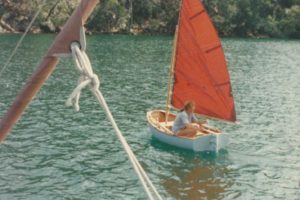 The original Pee Wee was strip-planked and had an unstayed gunter rig, but the centreboard case just forward of the main thwart meant that the rower would often get a wet bum.
The original Pee Wee was strip-planked and had an unstayed gunter rig, but the centreboard case just forward of the main thwart meant that the rower would often get a wet bum.
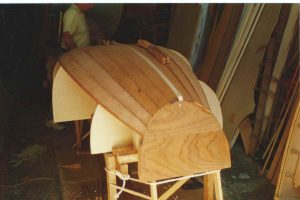
Pee Wee is built upside down, as in this shot of a half-planked boat in Australian Red Cedar.
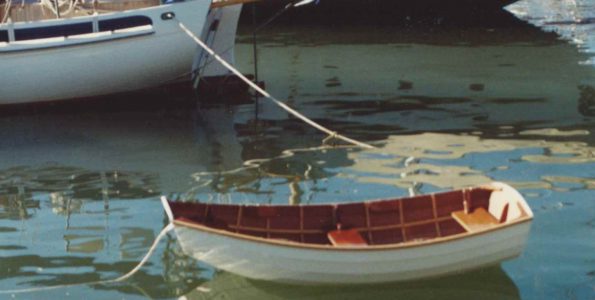
Petrel is a slightly larger version of the Pee Wee dinghy, designed by Nigel Shannon. It makes an ideal yacht tender with good performance characteristics like easy rowing and stability. Detailed building instructions are in the Wooden Boatbuilding – The Sydney Wooden Boat School Manuals. It can be built with traditional clinker planking, ply clinker planking, or strip-planked.
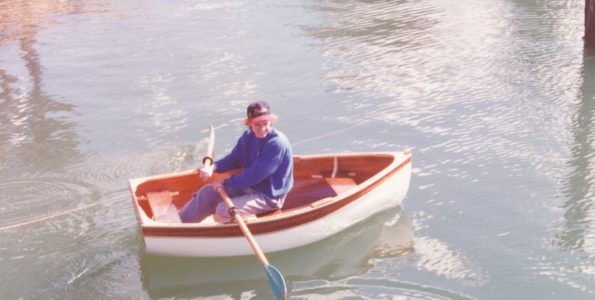
We were looking for a design for a stem dinghy that was only 2.2m long but could still be relatively stable as well as attractive. Jordan Smith drew up the lines and we built the first boat in a regional class in Newcastle in 1994. The boat proved to be exactly what we wanted, attractive and stable for its size. After that we built Pippies by four different methods, strip-planked, ply clinker, traditional clinker and diagonally-planked. Each method can produce a fine vessel.
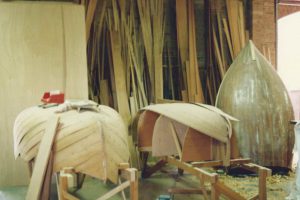
One customer built a traditional clinker version as a tender to his yacht and decided it was too nice to go in the water, so he turned it into a coffee table and built a plywood clinker version for a tender. I have an incomplete traditional clinker Cedar Pippy that will become the tender for my Ranger 24 when completed.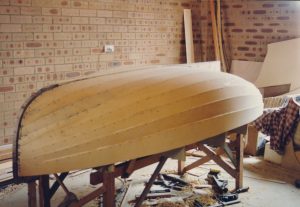
Generally speaking Pippy is built upside down in all methods, but the traditional clinker planked boat can be built right way up.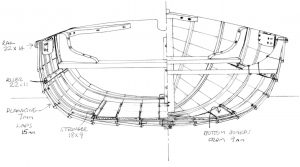
The construction details for strip-planking, traditional clinker construction and plywood clinker construction are all in the plans.
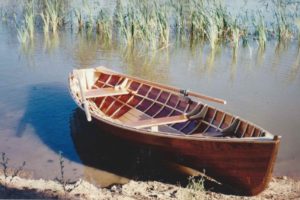 Bill Fisher of Drummoyne then Putney, from the famous Sydney boatbuilding family, built the original of this boat in his retirement for his own use in 1947. He built it like the Watermen’s skiffs that were common before the turn of the 20th Century when he began to learn his trade. Ian Smith took the lines off Eva Seabird in 1992, and quite a few boats have been built to this design since. It can be built traditionally clinker planked, or with glued plywood clinker construction or strip-planked. This boat pictured was built by Brendan McMurdo.
Bill Fisher of Drummoyne then Putney, from the famous Sydney boatbuilding family, built the original of this boat in his retirement for his own use in 1947. He built it like the Watermen’s skiffs that were common before the turn of the 20th Century when he began to learn his trade. Ian Smith took the lines off Eva Seabird in 1992, and quite a few boats have been built to this design since. It can be built traditionally clinker planked, or with glued plywood clinker construction or strip-planked. This boat pictured was built by Brendan McMurdo.
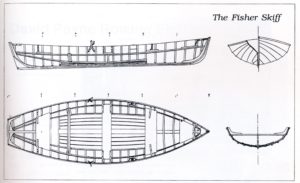
There is a separate construction plan for traditional clinker construction, and another sheet shows details for ply clinker and strip planking. Beam is 1.35m (4’5″). Eight-foot oars are about right.
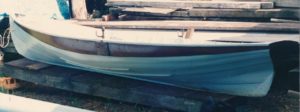 This is the original boat, known as the Eva Seabird. The family story goes that Bill Fisher wanted to call it Seabird but his sister Eva wanted it named after her, so it became Eva Seabird. In the 1950’s Bill , at the time in his 80’s, raced another veteran Tom Hall from Palm Beach to Manly (about 18 nautical miles, offshore) and won in a strong offshore Westerly. The builder’s great-grandson was working for me in 1992 at River Quays Marina opposite the Fisher shed in Putney, and Stuart rowed the boat to work. I asked his grandfather, the oldest family member still alive at that point if I could take off the lines, which he was happy to agree to.
This is the original boat, known as the Eva Seabird. The family story goes that Bill Fisher wanted to call it Seabird but his sister Eva wanted it named after her, so it became Eva Seabird. In the 1950’s Bill , at the time in his 80’s, raced another veteran Tom Hall from Palm Beach to Manly (about 18 nautical miles, offshore) and won in a strong offshore Westerly. The builder’s great-grandson was working for me in 1992 at River Quays Marina opposite the Fisher shed in Putney, and Stuart rowed the boat to work. I asked his grandfather, the oldest family member still alive at that point if I could take off the lines, which he was happy to agree to.
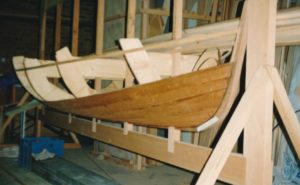 The first one we built was built at various shows in 1993. When our shed moved to Glebe Point we kept the boat in davits and often rowed it all around Sydney Harbour. This style of clinker boat is built upright when planked traditionally. The ply clinker and strip-planked versions are easier built upside-down.
The first one we built was built at various shows in 1993. When our shed moved to Glebe Point we kept the boat in davits and often rowed it all around Sydney Harbour. This style of clinker boat is built upright when planked traditionally. The ply clinker and strip-planked versions are easier built upside-down.
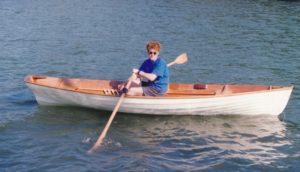 A ply clinker version was next, built in a Summer School class, and proved to be an excellent rowing boat like the traditional one, being lighter it was marginally faster, except against a headwind. The plans come with full-size patterns for the moulds as well as the stem and stern knees and transom.
A ply clinker version was next, built in a Summer School class, and proved to be an excellent rowing boat like the traditional one, being lighter it was marginally faster, except against a headwind. The plans come with full-size patterns for the moulds as well as the stem and stern knees and transom.
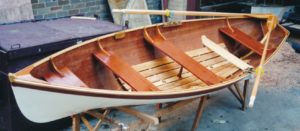 The first strip-planked version was next, also built in a class. This one also had a pair of custom 9’oars on fold-out rowlocks as requested by the customer who eventually bought it.
The first strip-planked version was next, also built in a class. This one also had a pair of custom 9’oars on fold-out rowlocks as requested by the customer who eventually bought it.
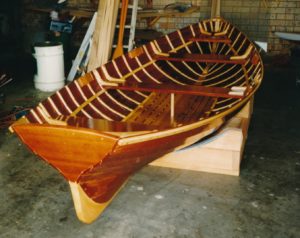 Several others have been built, including this beautiful traditional version by Allan Cumner in Bundaberg Queensland.
Several others have been built, including this beautiful traditional version by Allan Cumner in Bundaberg Queensland.
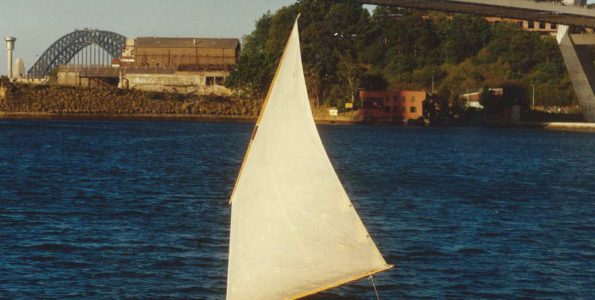
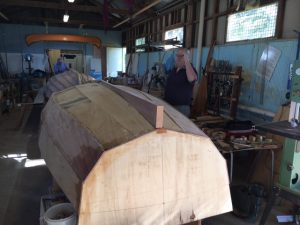 At the School in the early 1990’s we needed a boat that would be a good introduction to a number of boatbuilding techniques but be simple enough for a class to structurally complete in two busy weekends. I drew up the Whiting Skiff to be pretty much a maximum size for car-topping. The lucky result was that it is not only a good boat for learning techniques, it is a terrific boat in the water.
At the School in the early 1990’s we needed a boat that would be a good introduction to a number of boatbuilding techniques but be simple enough for a class to structurally complete in two busy weekends. I drew up the Whiting Skiff to be pretty much a maximum size for car-topping. The lucky result was that it is not only a good boat for learning techniques, it is a terrific boat in the water. 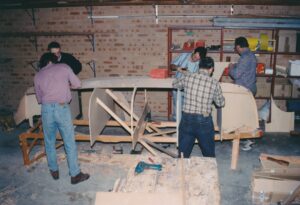 It can be rowed or sailed or even motored with a small outboard.
It can be rowed or sailed or even motored with a small outboard.
The plans contain two optional rigs, a simple unstayed standing lug rig and a gunter rigged sloop with small jib.
Full step-by-step instructions are found in my book Wooden Boatbuilding – The Sydney Wooden Boat School Manuals.
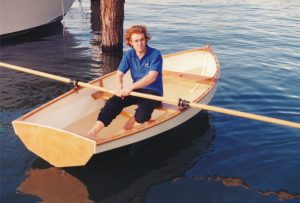
We still have one that we sail occasionally. It has proved to be an ideal boat for a Mens Shed project.
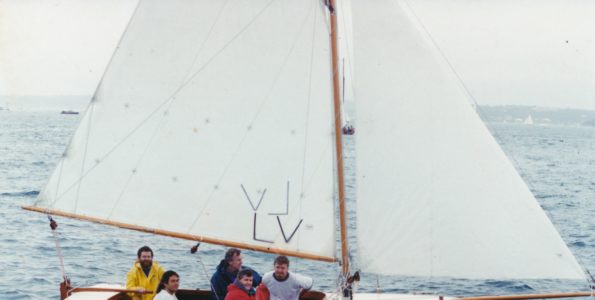
The Snapper Boat was drawn up for us by David Payne along the lines of the Snapper fishing boats of either side of the turn of the 20th Century. We were looking for a local working boat type that would be suitable as a half-decked family trailer-sailer with the option of an inboard engine and the Snapper Boat fits the bill admirably. The plans were drawn up for strip-planked construction, and the first few boats were built this way, but after a number of enquiries David and I worked up a clinker planking lineout and David drew a construction plan for plywood clinker construction.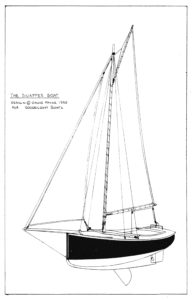
A number of other people admired the design as a motor boat without sailing rig, and a number of these have been built with larger motors than the sailing version. Some of the sailing versions have been built with an outboard under the aft deck working through a well built into the hull.
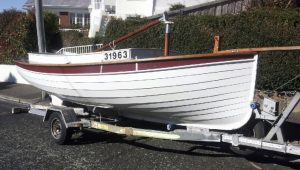
A Snapper Boat built with Ply Clinker planking
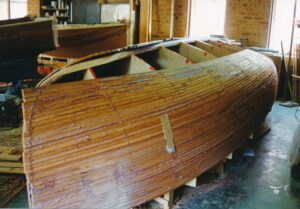
An easy boat to strip-plank.
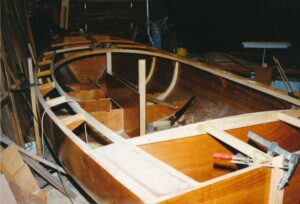
Internal structure and deck framing going into a strip-planked Snapper Boat.
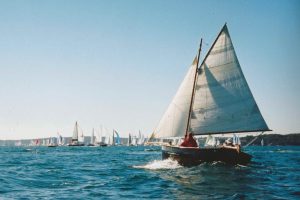
A great family sailer!
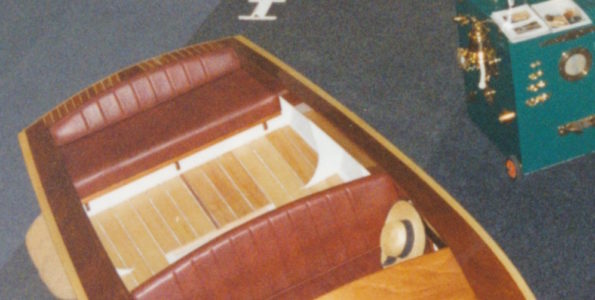
We asked David Payne to draw up this Aussie-style Clinker ski boat when increasing interest in this type of boat was becoming apparent. With the number of restorable boats decreasing, building from scratch is an option,especially now that the use of plywood clinker construction means that the boats will be stronger than they ever were, and leakproof, both of which are very important seeing these were the two main problems in the original traditionally-built boats. The hull will take up to a 350 V8 Chevy or Ford, and skiers would probably go for these, but a 179 Holden would still drive it along quite nicely as a runabout.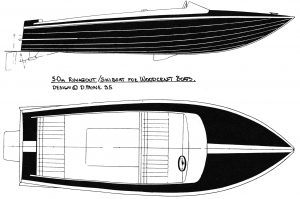
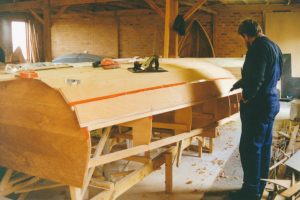
Ply clinker planking over ply frames on edge give this hull a strength the original boats never had.

The boat can be built with this built-in wind deflector or with a flush deck and windscreen.


